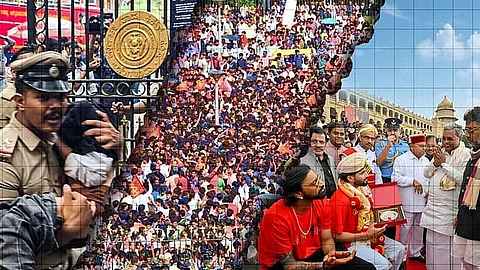

Follow TNM’s WhatsApp channel for news updates and story links.
The tragic stampede incident that occurred during the Royal Challengers Bengaluru (RCB) victory celebration on June 4 was the result of a series of grave failures by the organisers, including RCB, the Karnataka State Cricket Association (KSCA), and DNA Entertainment Networks, according to a status report filed by the Karnataka Home Department in the High Court.
Filed in response to a suo motu Public Interest Litigation initiated by the High Court, the status report squarely blames the organisers for conducting the event “unilaterally and without consultation or permission” from the city police. It points out how conflicting and delayed social media announcements by RCB led to a crowd of over 3 lakh people descending on a stadium with a capacity of just 35,000.
No permission, no plan
According to the report, at 6:30 pm on June 3, just an hour before the IPL final began, event organisers DNA submitted a letter on behalf of a KSCA official to the Cubbon Park Police Station merely intimating the possibility of a celebration in case of a win. But this was not a formal request for permission under the Licensing and Controlling of Assemblies and Processions (Bangalore City) Order, 2009.
“No applications in the prescribed formats were submitted... it was not possible for the licence-granting authority to consider the request positively,” the report says.
Despite this, on the morning of June 4, RCB began making a series of social media posts announcing a victory parade from Vidhana Soudha to the Chinnaswamy Stadium and a public celebration to follow.
Kohli’s video appeal
Another crucial point, according to the report, was a video shared by RCB at 8:55 am featuring Virat Kohli, one of the franchise’s most prominent players. In the video posted to RCB’s official handle on X (formerly Twitter), Kohli said the team was eager to celebrate the IPL win with the people of Bengaluru and RCB fans that very evening.
“The RCB shared a video clip of Virat Kohli... in which he stated that the team intended to celebrate this victory with the people of Bengaluru city and RCB fans,” the report notes.
This, the government says, significantly contributed to the massive turnout of fans who came expecting open entry, despite no approvals having been granted for such an event.
The report points out that the first post by RCB inviting fans was made at 7:01 am, and only at 3:14 pm, after thousands had already gathered, did RCB clarify that “limited free passes” were required, leading to confusion and chaos.
These posts by RCB on social media garnered immense engagement online, with approximately the first post receiving 16 lakh views, the second post (a repeat of the first post) attracting 4.26 lakh views, the third post (Kohli’s appeal) gaining 7.6 lakh views, and the fourth post achieving 17 lakh views,” the report points out.
“This led to a public gathering of immense proportions, exceeding 3,00,000 individuals,” the report states.
Stampede and chaos
The situation spiralled out of control by 3 pm. Entry gates remained closed, no public address systems were used to communicate with the crowd, and private security deployed by organisers had no instructions.
“This prompted the crowd to force their way into the stadium by breaking open Gate Nos. 1, 2, and 21,” the report says. Sporadic stampedes followed at multiple gates.
Seven police personnel were injured while controlling the crowd, including a DCP and three constables. Several civilians were injured, and at least a few were killed, though the report defers final casualty figures to an ongoing magisterial inquiry
Fearing a riot, police decided not to cancel the event but instead curtailed the programme and focused on crowd control.
“The risk of large-scale rioting... necessitated this careful balancing approach, prioritising overall public safety over immediate event cessation,” the report explains.
‘Organisers ignored safety protocols’
The report criticises the organisers’ disregard for safety and procedural norms.
“There were violations of safety standards… no signage, no communication systems to navigate crowds, no comprehensive instructions to trained staff, and no adequate speakers,” it says.
It also confirms that no medical arrangements were made by the organisers despite the ticket terms and conditions promising on-site first aid and emergency support.
Two ambulances and a fire tender were deployed only on the insistence of the local police.